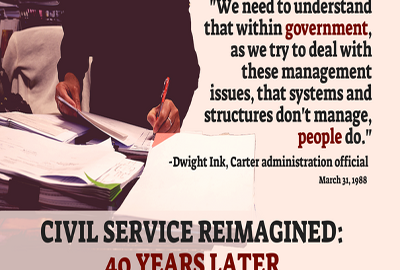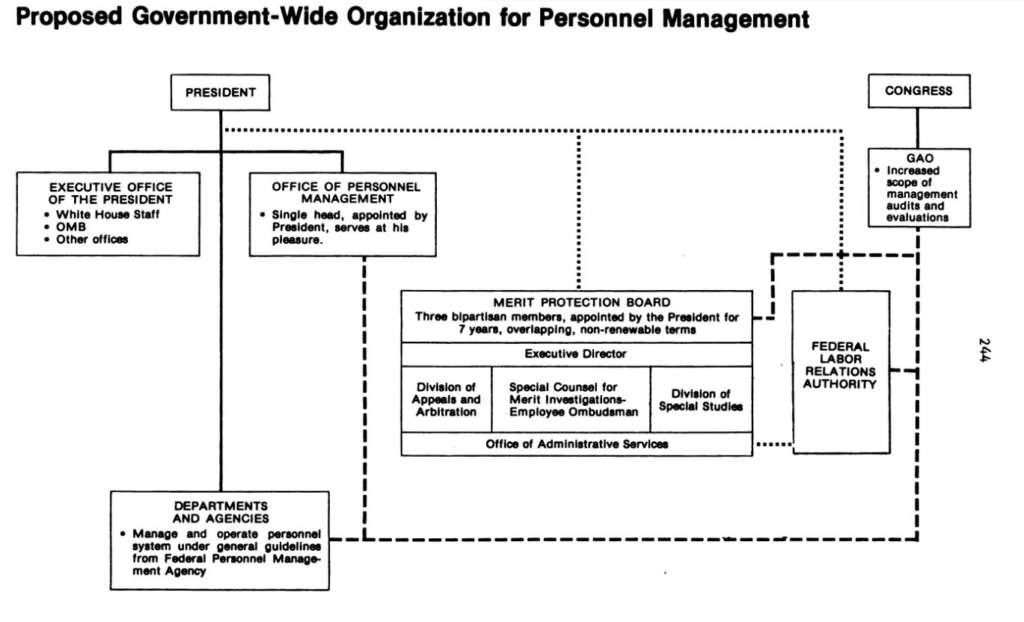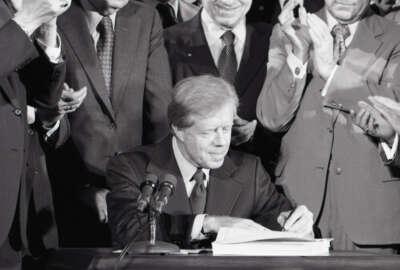
Does the administration have what it takes to reinvigorate an outdated civil service system?
In part three of its special report, "Civil Service Reimagined: 40 Years Later," Federal News Network looks at the Office of Personnel Management, and how it, past...
Best listening experience is on Chrome, Firefox or Safari. Subscribe to Federal Drive’s daily audio interviews on Apple Podcasts or PodcastOne.
Read the first two parts of Federal News Network’s Special Report: Civil Service Reimagined: 40 Years Later.
The Office of Personnel Management is having a midlife crisis.
About a week before the agency celebrates its 40th birthday, President Donald Trump replaced his OPM director of only six months with a political appointee from the Office of Management and Budget.
It came as a shock to OPM employees, many of whom learned of the shakeup from news reports.
But at the same time, Friday’s announcement is yet another event in a string of leadership vacancies, instability and highly-publicized mishaps that have marked OPM’s 40-year-history.
Today, the Trump administration and other critics of the agency say OPM — at least in recent years — has been asleep at the wheel. OMB, in describing its proposal to restructure OPM and shift most of its functions to other organizations within the federal government, cited “several high profile incidents,” such as a “flushing” scandal with the agency’s largest background investigations contractor and a major cybersecurity breach as having distracted OPM leadership from its core mission.
In interviews with former OPM officials, congressional oversight staffers and others in the federal community as part of Federal News Network’s special report, Civil Service Reimagined: 40 Years Later, experts say the agency isn’t necessarily to blame for its own undoing. Instead, they say OPM’s challenges are a symptom of a broader problem.
Congress, over time, has simply lost interest in it and the management of the federal workforce. Lawmakers have turned a blind eye to OPM and its leadership vacancies. They haven’t pushed the agency to take risks and consider how the civil service might position itself for the future.
And OMB, which has tightened its grip over OPM in recent years, has been its own distraction for the central personnel office.
“You can’t do difficult things in that job if you don’t have the support of the White House,” Don Devine, who led OPM for four years during the Reagan administration, said in an interview.
It’s not easy either, with “OMB sitting right across the street,” he added.
With the president’s announcement last week, OMB will soon sit much closer. Margaret Weichert, OMB’s deputy director for management, also will serve as OPM’s acting director for the foreseeable future.
OPM declined an interview request for this story.
Forty years ago, the Carter administration envisioned a central personnel entity that would advise the president and constantly “nurture” the federal workforce as the nature of work — and government — evolved over time.
Weichert and OMB have insisted their plan to reorganize and restructure OPM will do just what the Carter administration originally envisioned — and shed a shiny, new light on a stuffy and outdated civil service system.
But when it comes to the federal workforce, everyone — OPM, OMB, the White House and Congress — have collectively been operating in a series of fits and starts.
OPM “hasn’t kept up with the realities of work in America,” Paul Light, the Paulette Goddard professor of public service at New York University, said. “That’s what’s wrong with it. Just because it’s [from] 1978, the disco-ball civil service law, Title 5, doesn’t mean it’s bad. What it does suggest is that you better update it to deal with contemporary realities. OPM has not done the contemporary realities, and there’s been very little interest in civil service reform on Capitol Hill for the better part of two decades now.”
Distracted in 1978
The government’s federal personnel entity has always struggled to find its identity.
Even 40 years ago, authors of the Civil Service Reform Act agonized over finding the proper governance structure for a central federal personnel entity.
Administration officials who worked on President Jimmy Carter’s Personnel Management Project cited similar challenges back in 1978 with OPM’s predecessor, the Civil Service Commission.
The commission suffered because it was “expected to be all things to all parties,” and played multiple and “ill-fitting roles,” according to the Federal Personnel Management report, which top officials during the Carter administration prepared for the president’s consideration.
“The commission has become progressively less credible in all of its roles,” the report reads. “It has also dissipated its energies by distributing them over so many areas.”
The Carter administration decided to split the Civil Service Commission into three entities: OPM, the Equal Employment Opportunity Commission and the Merit Systems Protection Board.
OPM would advise the president on personnel matters for the federal workforce. Congress, with guidance from the Government Accountability Office, would hold OPM and agencies accountable.

Since 1978, OPM directors have enjoyed varying relationships with the White House and OMB.
Janice Lachance, who served as OPM director during the Clinton administration, said the agency benefited from being given cabinet status. She and OPM had a seat a table, which she said elevated the work that agency did during the Clinton administration.
“It was a signal of how much President [Bill] Clinton, Vice President [Al] Gore, and that administration respected and valued the federal workforce,” Lachance said. “That is something that I’m sorry has sort of disappeared over the years.”
OPM lost its cabinet status under the George W. Bush administration. OMB, meanwhile, began to take on a more active role in personnel policy. The administration established a new Office of Performance and Personnel Management, which sets and monitors cross-agency priority goals but also coordinates with OPM to implement governmentwide policy.
“With OMB, there’s a natural tension, which still exists today,” Lachance said. “OMB has management in its title. HR is a core management function, so there’s always a natural tension there between the two organizations. Who has the last word? Who’s the final sign-off on things, so it behooves OPM and its political appointees to develop good relationships at OMB, but then OMB also has to respect OPM’s statutory authority, which says that OPM is the president’s authority on personnel matters.”
Interestingly enough, the original drafters of the reforms seriously considered recommending that this new central personnel entity reside within the Executive Office of the President, according to the Carter report. Carter, however, rejected this recommendation because he wanted to keep EOP as small as possible. Past presidents have typically struggled with the optics of growing the EOP and have tread carefully around the appearance of adding too many staff to the White House office.
But today, OMB has made a similar proposal. In addition to shifting OPM’s personnel policy functions to the White House, OMB also suggested moving OPM’s fee-for-service human resources consulting entity, governmentwide security clearances operation and health and retirement services to other agencies.
Devine, who is a proponent of merging OPM, OMB and the General Services Administration into one entity, said it’s notable that these most recent proposals have originated within OMB, not the Trump White House.
The three management agencies should, for operational purposes, situate themselves as one organization but only if that entity resides somewhere outside the White House grounds, Devine said. A central personnel organization should be out with the people it manages, who work and live across the country, he said.
Ultimately, OPM directors make the most progress if they have support from the White House and Congress, Devine said.
Though Devine said he enjoyed support from President Ronald Reagan, partisan politics in Congress interrupted his plans to achieve a merit-based pay system for mid-level managers.
From his vantage point as a former Oversight and Government Reform Committee chairman, Rep. Tom Davis (R-Va.) agreed.
“Strong leaders can overcome a bad system any day,” he said. “You can’t be a strong leader at OPM unless you have the president and the administration backing you up. But if they back you up, you can accomplish a lot of things without having to have legislative changes.”
But even if OPM is showing its age, some federal management experts fear the Trump administration’s current proposals to transform the agency in its current form may upend merit system principles, the very values that were supposed to be timeless.
Linda Springer, a former OPM director during the George W. Bush administration and former adviser for the Trump transition, said the proposed plans to reorganize OPM seem to stem from a philosophical predisposition.
“There are certainly businesses that OPM could shed that are better placed elsewhere,” she said. “OPM, like any agency, needs to continuously evaluate what it’s doing, how it is performing and what its mission should be going forward. The recent proposal goes beyond that. Prior performance issues don’t justify changes that risk impairing fundamental civil service protections. Congress understood that in 1978, and I hope they still do today.”
Congress lacks interest
Former OPM directors, congressional oversight staffers and other members of the federal community agree: The agency never recovered from the 2015 cyber breaches that compromised the personal data of 21.5 million employees, contractors and others.
The cyber breach was a turning point for the agency. But it also marked a distinct difference in OPM’s relationship with Congress.
Former OPM officials and congressional staffers say they once enjoyed a collaborative working relationship with other each.
“The OPM congressional team was in our office constantly,” said one former Senate governmental affairs committee staffer, who didn’t receive permission from a current employer to speak to the press. “It really was a proactive partnership and a proactive relationship. They knew what we were working on, we were very transparent with them, and we would always go and ask them for advice, guidance and assistance.”
Dan Blair, who served as an acting and deputy OPM director during the George W. Bush administration, recalled testifying before lawmakers at least two dozen times during his four-year tenure at the agency.
But Blair said he witnessed the collaborative relationship even before he joined OPM. He started his career as a staffer on the then-House Post Office and Civil Service Committee. Congress had the resources to dedicate to separate subcommittees on the Postal Service, District of Columbia and the civil service.
Today’s House Oversight and Government Reform Committee has one subcommittee on “government operations.”
Springer also said she and her staff met with congressional offices frequently. Sens. George Voinovich (R-Ohio) and Dan Akaka (D-Hawaii), then the leaders of the Homeland Security and Governmental Affairs subcommittee dedicated to federal management, were particularly interested in improving the civil service.
But even these senators met roadblocks during their time on the committee, trying several times to pass new legislation to improve the federal hiring process and boost supervisory training with limited success.
“It was generally a proactive and collaborative type of relationship rather than a reactive one,” Springer said. “Today, what I observe as an outsider is that many of the interactions seem to be in response or in reaction to an event, and the benefits of advance collaboration are foregone.”
Former congressional staffers and others like Blair echoed Springer’s comments, pointing to a relationship that went from proactive and cooperative to one that has dissipated as lawmakers’ interest in the federal workforce waned as more pressing issues took importance.
Interest returned, for a fleeting second, during the aftermath of the OPM breaches in 2015.
“That really wasn’t oversight,” Blair said. “Those were hearings on a specific instance on what it was going to take to ameliorate and correct what had happened. I wouldn’t call that systemic oversight.”
Though the 2015 breach briefly renewed congressional interest in OPM, lawmakers quickly paid less attention during the three years that followed.
Beth Cobert replaced Katherine Archuleta, who resigned in the aftermath of the security breaches. The Senate never confirmed Cobert because some senators took issue with a determination OPM had made years earlier on the Affordable Care Act. Multiple requests to Cobert for an interview went answered.
Trump left the OPM director’s position unnamed and unfilled for the first nine months of his presidency. His first nominee, George Nesterczuk, never got a nomination hearing and withdrew his name from consideration, in part, because the vetting process took too long.
Jeff Pon then waited another six months before Congress agreed to set aside its concerns with the same, politically-driven objection to the Affordable Care Act, and confirmed him, only then to have Pon leave six months later.
Risk-averse and out of touch
As Congress lost interest in performing even its basic functions like staffing OPM, it also failed to hold the agency accountable to its true mission: leading and guiding the federal workforce through times of change.
As a result, the agency kept its head down as millennials started to enter the workforce and technology shifted, NYU’s Light said.
“OPM just hasn’t kept up, in part, because Congress and presidents have ignored these great workforce transitions,” he said. “OPM is in the unenviable position of managing a failing statute that’s no longer relevant to the workforce of today — and of managing that statute in the worse way possible.”
It hasn’t been without trying. OPM launched at least seven different hiring improvement programs over the past 10 years. It secured changes to the federal internship program. And even though participation has been tepid at best, OPM did eventually launch the phased retirement program, which was long sought-after.
For former Congressman Davis, Congress hasn’t helped foster an environment where agencies like OPM feel free to innovate and try new things.
“We’re too quick to blame the system and say you need new laws where you really need a can-do attitude and recognize what can happen,” he said. “So often, federal employees do not get rewarded for being innovative. They get rewarded for basically staying within their box, not making [a] mistake.”
Meanwhile, good government groups and other stakeholders are itching to upend the risk-averse culture and finally right some of the wrongs with the existing federal personnel system that they, and employees themselves, have been challenged with for decades.
First, it’s time to pay more attention to the issues lawmakers have largely avoided in recent years, former OPM deputy director Blair said.
“We’re really at a point in our civil service … [where] we need to make sure that we have a system in place that can bring qualified people on relatively quickly, and we have systems in place that will retain them as well,” he said.
Partisan politics need to be left at the door, Blair added. Otherwise, government will continue to suffer.
And when it comes to reimagining the civil service, the 40th anniversary shouldn’t be a signal to completely trade in the sensible sedan for a shiny, new sports car, past OPM officials said. The agency’s employees have built up a body of expertise over the past four decades, and they’re strong stewards of the merit system, Springer said.
“It’s a good time in this anniversary period to acknowledge all the accomplishments of the past 40 years,” she said. “Without the expertise and guidance of OPM, we would be in a very different place today. I think that they got it right in 1978.”
Whatever shape OPM — or another entity — takes in the future, it’s crucial new administrations consider the values that informed the 1978 law.
The National Academy of Public Administration weighed in on this issue in its most recent report on the state of the civil service system. Though it didn’t bite on the question of who should serve as a central personnel entity, the organization did unequivocally say there should be such an organization.
“Without such an entity, [government’s] ability to keep up with future changes — let alone lead them — will surely suffer,” the panel said.
Copyright © 2025 Federal News Network. All rights reserved. This website is not intended for users located within the European Economic Area.
Nicole Ogrysko is a reporter for Federal News Network focusing on the federal workforce and federal pay and benefits.
Follow @nogryskoWFED





